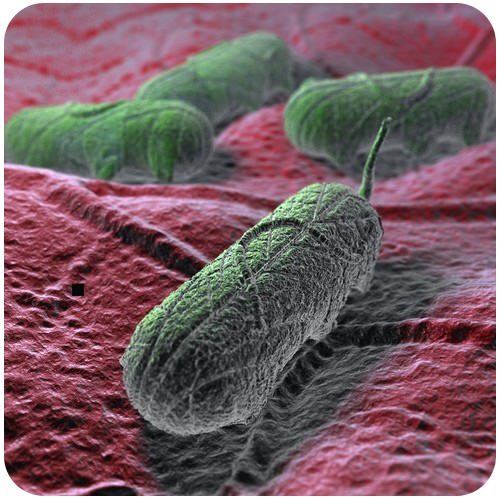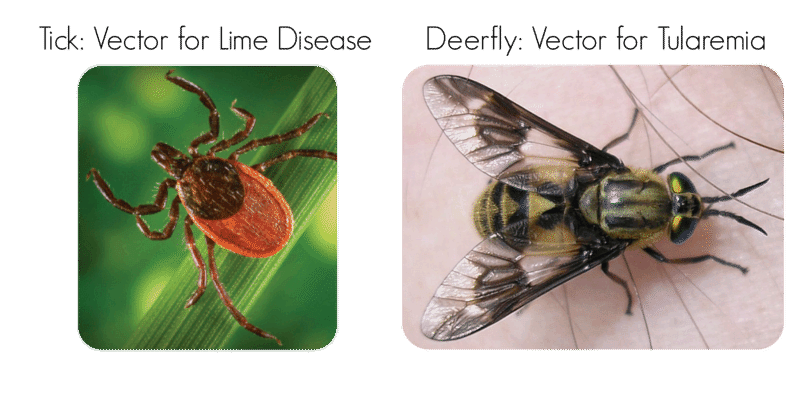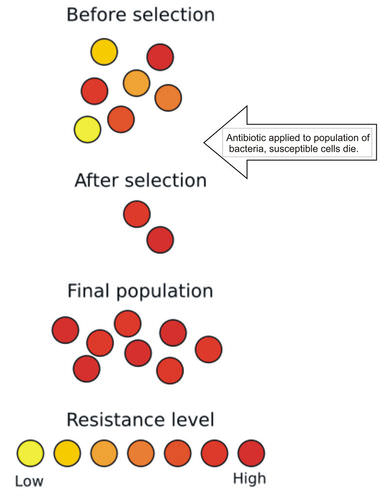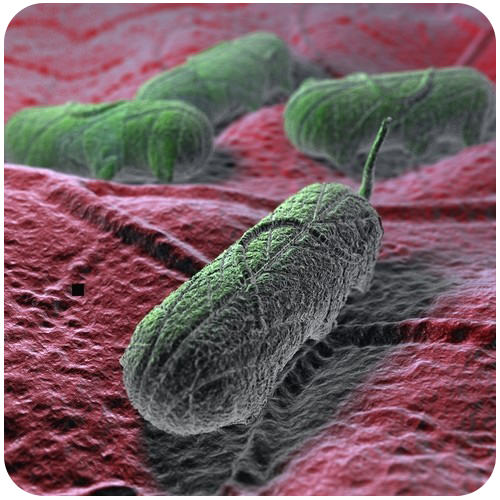7.15: Bacteria and Humans
- Page ID
- 12182
\( \newcommand{\vecs}[1]{\overset { \scriptstyle \rightharpoonup} {\mathbf{#1}} } \)
\( \newcommand{\vecd}[1]{\overset{-\!-\!\rightharpoonup}{\vphantom{a}\smash {#1}}} \)
\( \newcommand{\dsum}{\displaystyle\sum\limits} \)
\( \newcommand{\dint}{\displaystyle\int\limits} \)
\( \newcommand{\dlim}{\displaystyle\lim\limits} \)
\( \newcommand{\id}{\mathrm{id}}\) \( \newcommand{\Span}{\mathrm{span}}\)
( \newcommand{\kernel}{\mathrm{null}\,}\) \( \newcommand{\range}{\mathrm{range}\,}\)
\( \newcommand{\RealPart}{\mathrm{Re}}\) \( \newcommand{\ImaginaryPart}{\mathrm{Im}}\)
\( \newcommand{\Argument}{\mathrm{Arg}}\) \( \newcommand{\norm}[1]{\| #1 \|}\)
\( \newcommand{\inner}[2]{\langle #1, #2 \rangle}\)
\( \newcommand{\Span}{\mathrm{span}}\)
\( \newcommand{\id}{\mathrm{id}}\)
\( \newcommand{\Span}{\mathrm{span}}\)
\( \newcommand{\kernel}{\mathrm{null}\,}\)
\( \newcommand{\range}{\mathrm{range}\,}\)
\( \newcommand{\RealPart}{\mathrm{Re}}\)
\( \newcommand{\ImaginaryPart}{\mathrm{Im}}\)
\( \newcommand{\Argument}{\mathrm{Arg}}\)
\( \newcommand{\norm}[1]{\| #1 \|}\)
\( \newcommand{\inner}[2]{\langle #1, #2 \rangle}\)
\( \newcommand{\Span}{\mathrm{span}}\) \( \newcommand{\AA}{\unicode[.8,0]{x212B}}\)
\( \newcommand{\vectorA}[1]{\vec{#1}} % arrow\)
\( \newcommand{\vectorAt}[1]{\vec{\text{#1}}} % arrow\)
\( \newcommand{\vectorB}[1]{\overset { \scriptstyle \rightharpoonup} {\mathbf{#1}} } \)
\( \newcommand{\vectorC}[1]{\textbf{#1}} \)
\( \newcommand{\vectorD}[1]{\overrightarrow{#1}} \)
\( \newcommand{\vectorDt}[1]{\overrightarrow{\text{#1}}} \)
\( \newcommand{\vectE}[1]{\overset{-\!-\!\rightharpoonup}{\vphantom{a}\smash{\mathbf {#1}}}} \)
\( \newcommand{\vecs}[1]{\overset { \scriptstyle \rightharpoonup} {\mathbf{#1}} } \)
\( \newcommand{\vecd}[1]{\overset{-\!-\!\rightharpoonup}{\vphantom{a}\smash {#1}}} \)
\(\newcommand{\avec}{\mathbf a}\) \(\newcommand{\bvec}{\mathbf b}\) \(\newcommand{\cvec}{\mathbf c}\) \(\newcommand{\dvec}{\mathbf d}\) \(\newcommand{\dtil}{\widetilde{\mathbf d}}\) \(\newcommand{\evec}{\mathbf e}\) \(\newcommand{\fvec}{\mathbf f}\) \(\newcommand{\nvec}{\mathbf n}\) \(\newcommand{\pvec}{\mathbf p}\) \(\newcommand{\qvec}{\mathbf q}\) \(\newcommand{\svec}{\mathbf s}\) \(\newcommand{\tvec}{\mathbf t}\) \(\newcommand{\uvec}{\mathbf u}\) \(\newcommand{\vvec}{\mathbf v}\) \(\newcommand{\wvec}{\mathbf w}\) \(\newcommand{\xvec}{\mathbf x}\) \(\newcommand{\yvec}{\mathbf y}\) \(\newcommand{\zvec}{\mathbf z}\) \(\newcommand{\rvec}{\mathbf r}\) \(\newcommand{\mvec}{\mathbf m}\) \(\newcommand{\zerovec}{\mathbf 0}\) \(\newcommand{\onevec}{\mathbf 1}\) \(\newcommand{\real}{\mathbb R}\) \(\newcommand{\twovec}[2]{\left[\begin{array}{r}#1 \\ #2 \end{array}\right]}\) \(\newcommand{\ctwovec}[2]{\left[\begin{array}{c}#1 \\ #2 \end{array}\right]}\) \(\newcommand{\threevec}[3]{\left[\begin{array}{r}#1 \\ #2 \\ #3 \end{array}\right]}\) \(\newcommand{\cthreevec}[3]{\left[\begin{array}{c}#1 \\ #2 \\ #3 \end{array}\right]}\) \(\newcommand{\fourvec}[4]{\left[\begin{array}{r}#1 \\ #2 \\ #3 \\ #4 \end{array}\right]}\) \(\newcommand{\cfourvec}[4]{\left[\begin{array}{c}#1 \\ #2 \\ #3 \\ #4 \end{array}\right]}\) \(\newcommand{\fivevec}[5]{\left[\begin{array}{r}#1 \\ #2 \\ #3 \\ #4 \\ #5 \\ \end{array}\right]}\) \(\newcommand{\cfivevec}[5]{\left[\begin{array}{c}#1 \\ #2 \\ #3 \\ #4 \\ #5 \\ \end{array}\right]}\) \(\newcommand{\mattwo}[4]{\left[\begin{array}{rr}#1 \amp #2 \\ #3 \amp #4 \\ \end{array}\right]}\) \(\newcommand{\laspan}[1]{\text{Span}\{#1\}}\) \(\newcommand{\bcal}{\cal B}\) \(\newcommand{\ccal}{\cal C}\) \(\newcommand{\scal}{\cal S}\) \(\newcommand{\wcal}{\cal W}\) \(\newcommand{\ecal}{\cal E}\) \(\newcommand{\coords}[2]{\left\{#1\right\}_{#2}}\) \(\newcommand{\gray}[1]{\color{gray}{#1}}\) \(\newcommand{\lgray}[1]{\color{lightgray}{#1}}\) \(\newcommand{\rank}{\operatorname{rank}}\) \(\newcommand{\row}{\text{Row}}\) \(\newcommand{\col}{\text{Col}}\) \(\renewcommand{\row}{\text{Row}}\) \(\newcommand{\nul}{\text{Nul}}\) \(\newcommand{\var}{\text{Var}}\) \(\newcommand{\corr}{\text{corr}}\) \(\newcommand{\len}[1]{\left|#1\right|}\) \(\newcommand{\bbar}{\overline{\bvec}}\) \(\newcommand{\bhat}{\widehat{\bvec}}\) \(\newcommand{\bperp}{\bvec^\perp}\) \(\newcommand{\xhat}{\widehat{\xvec}}\) \(\newcommand{\vhat}{\widehat{\vvec}}\) \(\newcommand{\uhat}{\widehat{\uvec}}\) \(\newcommand{\what}{\widehat{\wvec}}\) \(\newcommand{\Sighat}{\widehat{\Sigma}}\) \(\newcommand{\lt}{<}\) \(\newcommand{\gt}{>}\) \(\newcommand{\amp}{&}\) \(\definecolor{fillinmathshade}{gray}{0.9}\)
Can you guess what organisms are pictured here?
Are they fat green worms on a red leaf? Here’s a clue: There are more organisms like these than any other on Earth. Here’s another clue: Each organism consists of a single cell without a nucleus.
The organisms are bacteria called Salmonella. If the word Salmonella rings a bell, that’s probably because Salmonella causes human diseases such as food poisoning. Many other types of bacteria also cause human diseases. But not all bacteria are harmful to people. In fact, we could not survive without many of the trillions of bacteria that live in or on the human body.
Bacteria and Humans
Bacteria and humans have many important relationships. Bacteria make our lives easier in a number of ways. In fact, we could not survive without them. On the other hand, bacteria can also make us sick.
Benefits of Bacteria
Bacteria provide vital ecosystem services. They are important decomposers. They are also needed for the carbon and nitrogen cycles. There are billions of bacteria inside the human intestines. They help digest food, make vitamins, and play other important roles. Humans also use bacteria in many other ways, including:
- Creating products, such as ethanol and enzymes.
- Making drugs, such as antibiotics and vaccines.
- Making biogas, such as methane.
- Cleaning up oil spills and toxic wastes.
- Killing plant pests.
- Transferring normal genes to human cells in gene therapy.
- Fermenting foods (see Figure below).
 Fermented Foods. Fermentation is a type of respiration that doesn’t use oxygen. Fermentation by bacteria is used in brewing and baking. It is also used to make the foods pictured here.
Fermented Foods. Fermentation is a type of respiration that doesn’t use oxygen. Fermentation by bacteria is used in brewing and baking. It is also used to make the foods pictured here.Bacteria and Disease
You have ten times as many bacteria as human cells in your body. Most of these bacteria are harmless. However, bacteria can also cause disease. Examples of bacterial diseases include tetanus, syphilis, and food poisoning. Bacteria may spread directly from one person to another. For example, they can spread through touching, coughing, or sneezing. They may also spread via food, water, or objects.
Another way bacteria and other pathogens can spread is by vectors. A vector is an organism that spreads pathogens from host to host. Insects are the most common vectors of human diseases. Figure below shows two examples.
 Bacterial Disease Vectors. Ticks spread bacteria that cause Lyme disease. Deerflies spread bacteria that cause tularemia.
Bacterial Disease Vectors. Ticks spread bacteria that cause Lyme disease. Deerflies spread bacteria that cause tularemia.Humans have literally walked into some new bacterial diseases. When people come into contact with wild populations, they may become part of natural cycles of disease transmission. Consider Lyme disease. It’s caused by bacteria that normally infect small, wild mammals, such as mice. A tick bites a mouse and picks up the bacteria. The tick may then bite a human who invades the natural habitat. Through the bite, the bacteria are transmitted to the human host.
Controlling Bacteria
Bacteria in food or water usually can be killed by heating it to a high temperature (generally, at least 74°C, or 165°F). Bacteria on many surfaces can be killed with chlorine bleach or other disinfectants. Bacterial infections in people can be treated with antibiotic drugs. For example, if you ever had “strep” throat, you were probably treated with an antibiotic.
Antibiotics have saved many lives. However, misuse and over-use of the drugs have led to antibiotic resistance in bacteria. Figure below shows how antibiotic resistance evolves. Some strains of bacteria are now resistant to most common antibiotics. These infections are very difficult to treat.
 Evolution of Antibiotic Resistance in Bacteria. This diagram shows how antibiotic resistance evolves by natural selection.
Evolution of Antibiotic Resistance in Bacteria. This diagram shows how antibiotic resistance evolves by natural selection.Science Friday: Your Very Special Bacterial Cloud
There is a cloud surrounding you, formed by billions of bacteria that slough off your body with every movement you make. In this video by Science Friday, researchers at the University of Oregon, revealed that they can detect and catalog this unique personal microbial cloud.
Science Friday: Subvisual Subway: The Art of New York City's Bacterial World
An urban legend states that "using the handrails on the subway is like shaking hands with 100 people." In this video by Science Friday, Craig Ward sampled the bacteria on subway lines around New York City to create striking and unconventional "portraits" of NYC commuters.
Summary
- Bacteria and humans have many important relationships. Bacteria provide humans with a number of services. They also cause human diseases.
Review
- How can bacteria cause disease?
- List three benefits of bacteria.
- How can bacteria be killed?
| Image | Reference | Attributions |
 |
[Figure 1] | Credit: User:Wykis/Wikimedia Commons, modified by CK-12 Foundation Source: commons.wikimedia.org/wiki/File:Antibiotic_resistance.svg License: CC BY-NC |
 |
[Figure 2] | Credit: Left to right: Flickr:LWY; Flickr:dustingrzesik; Christian Bauer; User:Omernos/Wikimedia Commons Source: Left to right: www.flickr.com/photos/86688834@N00/2143709720 ; http://www.flickr.com/photos/80707662@N02/8326034806/ ; commons.wikimedia.org/wiki/File:Swiss_cheese_cubes.jpg ; commons.wikimedia.org/wiki/File:Labneh01.jpg License: Left to right: CC BY 2.0; CC BY 2.0; CC BY 2.0; Public Domain |
 |
[Figure 3] | Credit: Tick: Courtesy of Centers for Disease Control and Prevention; Deerfly: User:Pudding4Brains/Wikimedia Commons Source: Tick: http://www.fda.gov/forconsumers/consumerupdates/ucm049298.htm ; Deerfly: commons.wikimedia.org/wiki/File:Daas_op_been_%28omgeving_Goor%29.jpg License: Public Domain |
 |
[Figure 4] | Credit: User:Wykis/Wikimedia Commons, modified by CK-12 Foundation Source: commons.wikimedia.org/wiki/File:Antibiotic_resistance.svg License: Public Domain |

